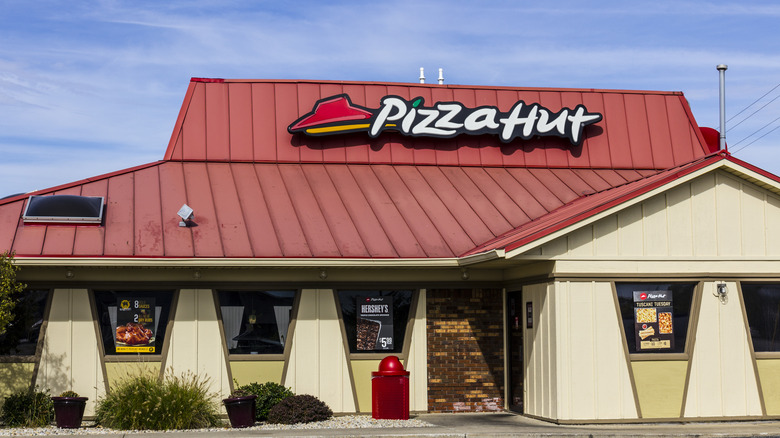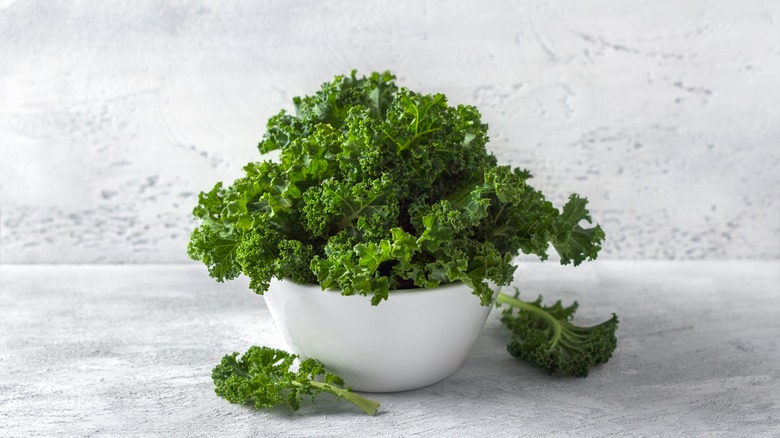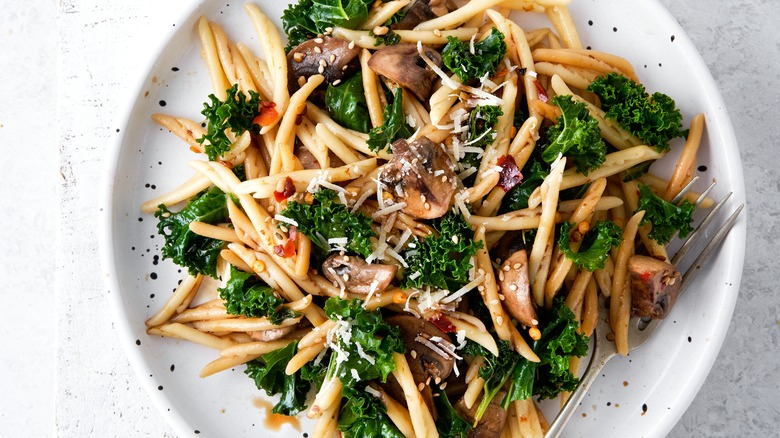Pizza Hut Was Once One Of The Biggest Kale Buyers In The US
Why does kale, touted as a superfood, continue to divide us? Kale, according to Britannica, is in the Brassica family along with cabbage, brussels sprouts, broccoli, mustard, cauliflower, kohlrabi, and collard greens — which are all variants of the same plant, wild cabbage or Brassica oleracea (per Insider) that have been cultivated for their specific edible parts. For kale, that's the leaves, which can be dark blue-green, purple or red and deeply ruffled or savoyed — wrinkly in produce terms (per Merriam-Webster). Kale is grown in the cooler months of fall and winter because it's hardy and its flavor gets better with the cold (great because some think it needs all the help it can get).
Google Trends charted kale's rise to power, illustrating its promotion to the jolly green mascot for healthy living for the last decade or so. But it wasn't always this way. A gardening article in The New York Times indicates that kale cultivation originated in Europe as an essential but unglamorous winter food crop with multiple types that look quite different from the leafy green we know today.
Before the kale craze began, America's largest buyer of kale was not health food stores or eco-conscious vegan restaurants. It was Pizza Hut. Yes, Pizza Hut in all its cheesy, greasy, meaty glory. And the reason why the chain purchased so much will surprise you.
Kale was just for decoration
As Healthline reports, though raw kale can negatively affect certain bodily systems for some people, overall kale lives up to its superfood reputation, packing impressive amounts of nutrients including vitamins A, B, C, and K, minerals like calcium, potassium, magnesium, copper, and manganese, and protective antioxidants — but that's not why Pizza Hut was buying so much of it. Their reasoning was more about the aesthetic.
Kale was used for decorative purposes on the salad bar at Pizza Hut, but it was not originally intended to be eaten. It was meant to be a frilly green garnish, and a lacey disguise for the ice that kept the food there cold, according to Today's interview with a Pizza Hut spokesperson — with some 14,000+ pounds bought in 2012 alone. Nowadays you'll find kale in everything from salads to smoothies, transformed into dishes as wide-ranging as hearty soups and air-fried kale chips. There are restaurants named after kale and ironically, places that serve kale-topped pizza.
How to buy and cook kale
Since kale has been promoted from salad bar garnish to food for the health-conscious, Foodprint's Seasonal Food Guide says to seek kale with healthy, rigid, dry stalks and leaves and stay away from anything brown, limp, or squishy. It's great to support local farmers whenever you can, but kale is everywhere these days. You may want to opt for organic, though. The Environmental Working Group cautions that currently, kale is among the most pesticide-laden vegetables on the market.
Soaking kale can help in the flavor and texture department. Healthline tells us that lightly steaming kale preserves the most nutrients and overcooking reduces them. Women's Health Magazine explains that removing the hard stems and massaging kale with oil and salt helps break down its fibrous leaves, making it easier to eat. The magazine adds that eating kale with oil also helps us get its fat-soluble vitamins.
Try festive kale and apple salad with maple mustard dressing, or gather 'round a plate of healthy homemade calzones with kale filling. Rachael Ray's hearty Portuguese Chourico and Kale Soup will warm you up and Ree Drummond's panfried kale couldn't be a simpler side dish. Now you know the truth behind kale, it's time to lend its gorgeous color and healthy, cruciferous crunch to your weekly cooking.


